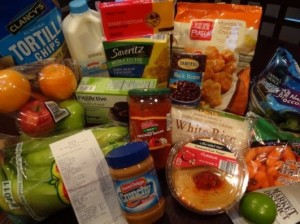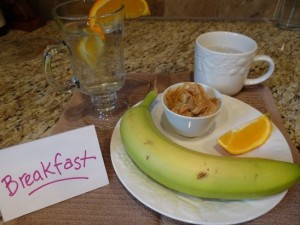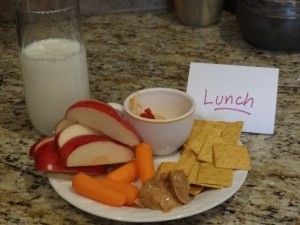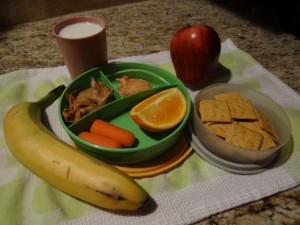What would you eat if you could only spend $1.50/meal? The “SNAP Challenge” asks participants to experience eating on a very limited food budget comparable to that of a Supplemental Nutrition Assistance Program, or SNAP, recipient.
This month I decided to give the challenge a try for 6 days, which meant I had $27 to spend. My shopping trip through a small, discount grocery store took much longer than usual, as I carefully thought through which foods would mix-and-match well and provide a fairly nutritious diet. If I had been in a hurry or if I had small children along with me, it would have been very difficult to add up the costs of my items and select –and reselect—my purchases. My main purchase totaled $26.61. I also bought a lime for 50 cents, but since that put me over the $27 limit I decided not to eat it during the 6-day challenge period. Here is what I bought:
What did I eat? During the six days, I only ate the foods pictured above and turned down free food from friends, family, or while at work. There was no eating out, since I spent my entire allotment on groceries. I ate foods I like, though there wasn’t much variety and there was room for improvement nutritionally. Most of my meals consisted of:
Breakfasts: A banana with peanut butter, water with orange slices, and plain hot water.
Lunch: Crackers and red pepper hummus, apples and peanut butter, and milk.
Snacks: Tortilla chips and salsa (sometimes cheese or carrots, too).
Dinners: Rice, broccoli, carrots, and chicken with Mandarin orange sauce, OR, rice, beans, chicken, salsa and chips, topped off with 2 cookies and milk.
Sometimes breakfast and lunch were “on the go”.
Over 45 million low-income individuals, or about 1 in 7 Americans, participate in SNAP to help purchase food. My experience this week was a reminder of what these families and individuals experience when buying food. I know they also make difficult choices between groceries, medical expenses, transportation, housing costs, utilities, and other household necessities.
OSU Extension provides nutrition education for eligible low-income individuals through SNAP-Ed and the Expanded Food and Nutrition Education Program (EFNEP) funded by the USDA. The goal of these programs is to improve the likelihood participants will make healthy food choices within a limited budget consistent with the current US Dietary Guidelines and other recommendations. SNAP-Ed is available in 64 counties and EFNEP is offered in 66 counties throughout Ohio.
What are some of the challenges you have faced buying healthy foods on a limited budget?
For more information on SNAP-ED and EFNEP, visit http://fcs.osu.edu/nutrition
Written By:
Carol Smathers, MS, MPH
Field Specialist
Ohio State University Extension
smathers.14@osu.edu
Reviewed By:
Bridgette Kidd, MPH, RD
Program Specialist, Healthy People
Ohio State University Extension
Sources:
SNAP-Ed Factsheet. USDA Food and Nutrition Service. Access at http://snap.nal.usda.gov/snap/SNAP-EdFactsheet2012.pdf








